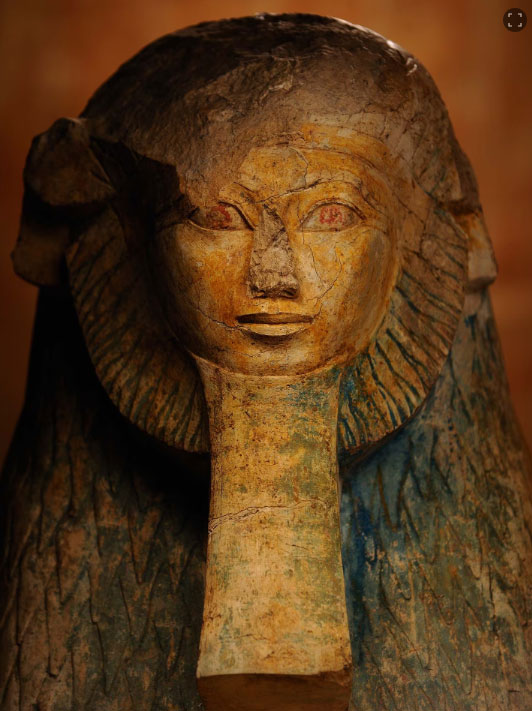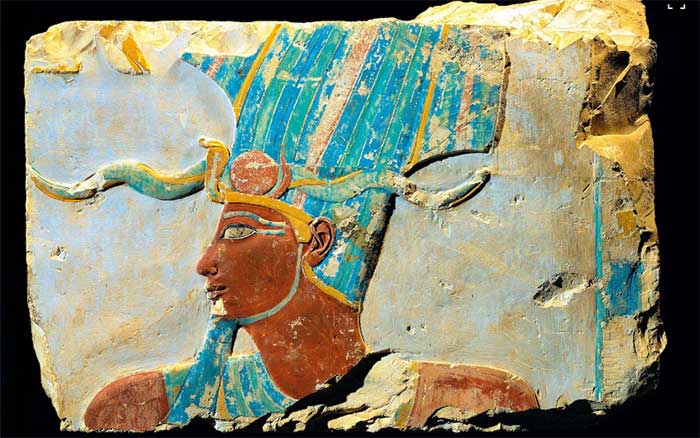Legend of the first woman to be an Egyptian pharaoh
Including the time she served as regent and pharaoh (king of Egypt), Hatshepsut ruled Egypt for a total of 21 years.
The mark of the woman who became the Pharaoh

Hatshepsut is depicted as a sphinx with a lion's head. She wears the traditional male symbol of a lion's mane and a fake pharaoh's beard - a sign of royalty. (Photo: National Geographic)
According to National Geographic magazine, Hatshepsut is one of the few women in Egyptian history to hold power for such a long time. She ruled during one of the golden ages of ancient Egypt, when Egypt was very prosperous. Hatshepsut built monumental structures across Egypt: countless temples, four giant obelisks at the Temple of Amun in Karnak, and countless works of art honoring her achievements.
Hatshepsut was born around 1507 BC, the child of Thutmose I and his royal wife Queen Ahmose. Later, Hatshepsut married Thutmose II - his half-brother and heir to the throne, and then became his great royal wife.
Thutmose II died young, leaving behind a young son as his second wife's son and heir. Thutmose III was too young to rule Egypt, so Hatshepsut, who was both the boy's aunt and stepmother, ruled in his stead as regent.

The image of Thutmose III is depicted on a colored relief at Deir el Bahri. (Photo: National Geographic).
Hatshepsut gradually transitioned from her role as queen regent to full-blown Pharaoh . As Thutmose III grew older, he was second in power to her and only had the right to rule Egypt outright as Pharaoh until after her death around 1458 BC.
Hatshepsut probably knew her position was tenuous because she was a woman and because her claim to the throne was unusual. So she did what wise leaders do in times of crisis: she reinvented herself . The most obvious form is that she portrays herself as a male Pharaoh. As for why, no one really knows, but experts say it was because she co-ruled Egypt with a man - a situation no woman had ever had to face.
However, she does not pretend to be a man and does not cross-dress. The inscriptions on statues of Hatshepsut almost always contain some indication of her actual gender, such as the words 'Daughter of Re' or the feminine.
Hatshepsut also took the new name Maatkare , meaning Soul (ka) of the Sun god (Re). The important word in the name here is maat - the ancient Egyptian expression for order and justice established by the gods. Maintaining maat to ensure prosperity and stability of the country required a legitimate Pharaoh who could speak directly to the gods. This is something only Pharaohs can do. By calling herself Maatkare, Hatshepsut may have reassured her people that they had a legitimate ruler on the throne.
It can be said that Hatshepsut was one of the most influential and powerful Pharaohs of the 18th Dynasty of Egypt . But she faced countless discrimination and prejudice during her reign, simply because she was a woman who ruled during a time when patriarchy was the dominant norm. Therefore, she had to overcome many stereotypes about women in power.
Despite many obstacles, Hatshepsut changed social standards for women in ancient Egyptian society. She proved that women can become independent leaders and can do anything.
One of the most notable achievements of Hatshepsut's rule were the trade missions to Punt, a sub-Saharan kingdom near Egypt. During this expedition, Hatshepsut contacted the leader of Punt directly and brought back many goods such as gold, ebony, and ivory. This mission was especially significant for her rule because it showed the Egyptian people that a woman could be independent, resourceful, and self-reliant. She was able to organize the entire trip and even confer with a highly respected leader in the Sahara region. Because she was treated as an equal by this leader, the Egyptian people saw that Hatshepsut was an honorable and trustworthy Pharaoh.
Hatshepsut also commanded several military campaigns, including one in Nubia and another in the Levant. She expanded Egyptian control and trade in these areas, and brought back valuable resources such as wood and precious metals.
Military campaigns in Nubia aimed to secure valuable resources such as gold, ivory, and incense, while also protecting Egypt from potential invasions from the south.
Not only was Hatshepsut a successful ruler, she was also a patron of art and architecture. She built many monumental works, such as the temple of Amun at Deir el-Bahri, the temple of Anubis at Wadi el-Shatt el-Rigga.
She also renovated and expanded many existing architectural works, including KarnACK temple and Luxor temple.
Million year old temple

Photo taken of Hatshepsut temple in 1955. (Photo: National Geographic).
During the New Kingdom of Egypt, (also known as the Egyptian Empire, which lasted from the mid-16th century BC to the 11th century BC), Hatshepsut was one of the first Pharaohs to build a Temple. of Millions of Years (roughly translated: Million-year-old temple) on the west bank of the Nile River, opposite the city of Thebes (present-day Luxor).
Five centuries earlier, during the Middle Kingdom of Egypt (circa 2050 BC to 1700 BC), Pharaoh Mentuhotep II built the first mortuary temple here. Perhaps inspired by Mentuhotep, Hatshepsut built this massive site at the foot of a cliff at what is now Deir el Bahri. This sacred site was consecrated to the goddess Hathor - protector of the dead and an important funerary deity in Thebes.
In these temples, the Pharaohs would be worshiped after their deaths. Meanwhile, their mummies rest elsewhere, buried in separate underground chambers in the Valley of the Kings. Not only used for royal funerals, the million-year-old temples were also the focus of other ceremonies: some related to royalty, others to the gods. Of all the funerary temples, the Hatshepsut temple would later become the main structure of the Theban site.
The construction of this million-year-old Temple (also known as Hatshepsut Temple) lasted about 15 years under the supervision of Senenmut, a high-ranking official and trusted by Hatshepsut. This magnificent building has the same ramps and courtyards as the nearby temple of Mentuhotep, but Senenmut introduced a number of improvements to create a building of unparalleled splendor. The building has the name Djeser-Djeseru, meaning 'holy place of sacred places'.
The temple of Hatshepsut is arranged around a central ramp. Spread along this slope at different heights are three large courtyards.

Illustration of the temple of Hatshepsut at its peak of splendor. (Photo: National Geographic).
Today, the walls and courtyards of Hatshepsut's temple may look a bit plain, but in her time they were filled with vibrant colors, surrounded by lush gardens and pools, and lavishly decorated. with sculptures and reliefs. Each decorative element conveys a religious or political message appropriate to the building's ceremonial use.
The layout of the temple of Hatshepsut was carefully designed. Most obvious is that the temple's location is completely consistent with the temple of Amun at Karnak, on the opposite bank of the Nile. In addition, the exact East - West direction of the slope simulated the daily path of the Sun, or according to beliefs at that time, the path of the god Re.
The temple is also in harmony with the Valley of the Kings located to the west. This royal cemetery was inaugurated by Hatshepsut's father, Thutmose I. In fact, tomb KV20 - the burial place of Hatshepsut and Thutmose I - is located in a straight line from the sanctuary of Amun, the innermost chamber of Hatshepsut's temple. Some experts believe that the original plan was to connect KV20 with the holy site of Amun through a tunnel through the intervening cliff, but the poor quality of the rock prevented this from happening.
The stone railings on both sides of the central slope are guarded by huge stone lions. A row of columns separates the first and second courtyards. Around the second courtyard are famous bas-reliefs, depicting a caravan of traders that Hatshepsut sent to the Land of Punt.
Magnificent reliefs are carved on the eaves of the second courtyard of the temple at Deir el Bahri. Some describe Hatshepsut's expedition to Punt in the eighth and ninth years of her reign. The bas-reliefs show a glimpse of the terrain, fauna, flora and inhabitants of this mysterious land.
The expedition reached Punt by traveling along the Red Sea coast. The Egyptians loaded the ships with goods such as ivory, cinnamon, incense, cosmetics and animal skins. They also brought home myrrh plants grown in the temple complex of Hatshepsut. The bas-relief on the gate depicts these myrrh plants and also depicts Hatshepsut offering goods from Punt to the god Amun.
Other reliefs depict Hatshepsut's divine birth. She was believed to be the child of the god Amun-Re and Ahmose, the wife of Thutmose I. Hatshepsut's divine origin was an important tool in legitimizing her rule over Egypt.
In the second courtyard there are also two sanctuaries: one dedicated to the god Hathor and the other to the god Anubis.
24 giant statues line both sides of the entrance to the third courtyard. This is a statue of Pharaoh Hatshepsut impersonating Osiris, the god of the afterlife. She wears a false beard and the twin crowns of Upper and Lower Egypt, and she holds the royal emblem.
Hatshepsut built a number of sacred spaces in her temple at Deir el Bahri. The most famous of these is the sanctuary honoring Hathor, one of Egypt's oldest goddesses.
After her death, Hatshepsut was deliberately put into oblivion by Thutmose III. He ordered the destruction of all statues, monuments, and symbolic images of her, including depictions of her temple. Her image has been chiseled from monuments, her statues and works destroyed.
However, after a major reconstruction in the 20th century, the massive Hatshepsut temple at Deir el Bahri (Arabic for 'northern monastery') still stands today, hidden beneath the the red rock of a cliff. The beauty of this architectural wonder captivated the ancient world and is a testament to Hatshepsut's glory and her devotion to the gods.
- The death of the last Pharaoh
- The discovery of the temple of the Egyptian queen was rejected
- Identify the Egyptian pharaoh in the ancient tomb
- The 3,500-year-old seal of the Egyptian pharaoh
- The mysterious trumpet carries the curse of the Egyptian pharaoh
- Kiya - The most mysterious wife of the Egyptian pharaoh
- Rare bust discovered by ancient Egyptians
- Drawings in the youngest pharaoh tomb in Egypt reveal concussion
- The 4,300-year-old head statue was smashed by Egyptian pharaohs
- Discovered a new ancient Egyptian king
- Egyptian Pharaoh was the first to suffer from a giant disease
- The mystery of a woman's hair is still black even though she died 3,000 years
 The most famous scientific failures in history
The most famous scientific failures in history Mysterious genius mechanic and the machine froze time
Mysterious genius mechanic and the machine froze time The son carries the 'bad gene' of genius Albert Einstein
The son carries the 'bad gene' of genius Albert Einstein Isaac Newton
Isaac Newton